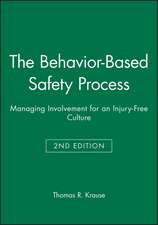Advances in Cognitive Engineering and Neuroergonomics: Advances in Human Factors and Ergonomics Series
Editat de Kay M. Stanney, Kelly S. Haleen Limba Engleză Hardback – 11 iul 2012
Preț: 674.85 lei
Preț vechi: 793.94 lei
-15% Nou
Puncte Express: 1012
Preț estimativ în valută:
129.17€ • 140.36$ • 108.58£
129.17€ • 140.36$ • 108.58£
Carte tipărită la comandă
Livrare economică 21 aprilie-05 mai
Preluare comenzi: 021 569.72.76
Specificații
ISBN-13: 9781439870167
ISBN-10: 1439870160
Pagini: 332
Ilustrații: 50
Dimensiuni: 156 x 234 x 24 mm
Greutate: 0.59 kg
Ediția:Revised
Editura: CRC Press
Colecția CRC Press
Seria Advances in Human Factors and Ergonomics Series
ISBN-10: 1439870160
Pagini: 332
Ilustrații: 50
Dimensiuni: 156 x 234 x 24 mm
Greutate: 0.59 kg
Ediția:Revised
Editura: CRC Press
Colecția CRC Press
Seria Advances in Human Factors and Ergonomics Series
Notă biografică
Stanney\, Kay M.; Hale\, Kelly S.
Cuprins
Volume 1: Advances in Cognitive Engineering and Neuroergonomics; Section I: Cognitive Engineering: Fundamentals; Chapter 1: Human factors in the design of a search tool for a database of Recorded Human Behavior; Chapter 2: Augmented Navigation: A Cognitive Approach; Chapter 3: Change Blindness When Viewing Web Pages; Chapter 4: Qualitative Facets of the Problem Statement; Chapter 5: Overloading Disks onto a Mind: Quantity Effects in the Attribution of Mental States to Technological Systems; Chapter 6: Effectiveness of Two-Channel Bone Conduction Audio Communication System in Speech Recognition Tasks; Chapter 7: Cognitive Ergonomics: The User and Brand in an Informational Relationship; Section II: Cognitive Engineering: Workload and Stress; Chapter 8: Cognitive Workload Analysis and Development of a Stress Index for Life Science Processes; Chapter 9: Interaction Effects of Physical and Mental Tasks on Auditory Attentional Resources; Chapter 10: Applicability of Situation Awareness and Workload Metrics for Use in Assessing Nuclear Power Plant Designs; Chapter 11: Effect of Occupational Stress among Workshop Trainees; Section III: Cognitive Engineering: Activity Theory; Chapter 12: On the Relationship between External and Internal Components of Activity; Chapter 13: Positioning Actions' Regulation Strategies; Chapter 14: Emotional-Motivational Aspects of a Browsing Task; Chapter 15: Using Systemic Approach to Identify Performance Enhancing Strategies of Rock Drilling Activity in Deep Mines; Section IV: Cognitive Engineering: Error and Risk; Chapter 16: Challenges in Human Reliability Analysis (HRA): A Reflection on the Accident Sequence Evaluation Program (ASEP) HRA Procedure 1; Chapter 17: Mirror Neuron Based Alerts for Control Flight Into Terrain Avoidance; Chapter 18: Computer Technology at the Workplace and Errors Analysis; Chapter 19: A Study on Document Style of Medical Safety Incident Report for Latent Factors Extraction and Risk-Assessment-based Decision Making; Section V: Cognitive Engineering:Applications; Chapter 20: Promoting Temporal Awareness for Dynamic Decision Making in Command and Control; Chapter 21: Data-driven Analysis and Modeling of Emergency Medical Service Process; Chapter 22: Age and Comprehension of Written Medical Information on Drug Labels; Chapter 23: Designing Virtual Reality Systems for Procedural Task Training; Section VI: Neuroergonomics: Measurement; Chapter 24: Given the State, What's the Metric?; Chapter 25: Development of a Neuroergonomic Application to Evaluate Arousal; Chapter 26: fNIRS and EEG Study in Mental Stress Arising from Time Pressure; Chapter 27: Availability and Future Prospects of Functional Near-infrared Spectroscopy (fNIRS) in Usability Evaluation; Chapter 28: Team Neurodynamics: A Novel Platform for Quantifying Performance of Teams; Section VII: Neuroergonomics: Applications; Chapter 29: Challenges and Opportunities for Inserting Neuroscience Technologies into Training Systems; Chapter 30: A Neuroergonomic Evaluation of Cognitive Workload Transitions in a Supervisory Control Task Using Transcranial Doppler Sonography; Chapter 31: From Biomedical Research to End User BCI Applications through Improved Usability of BCI++ v3.0; Chapter 32: An ERP Study on Instrument Form Cognition; Volume 2: Advances in Social and Organizational Factors; Section I: Perception and Design of Spaces; Chapter 1: Desirable Features of Contemporary Domestic Kitchen; Chapter 2: An Exploration about Interior Ambience Based on User-centered Design Approach; Chapter 3: Architecture as an Expression of Equity Polices in Manufacturing Plants in Poland; Chapter 4: Paradise Ambiance in Interactive Art: A Case Study of the National Palace Museum in Taipei; Chapter 5: Laboratory Kitchen and “Existenzminimum” Dwellings; Chapter 6: Intercultural Differences in the Formation of Space of the Courtroom; Chapter 7: Using Mental Models and Ergonomics to Analyze Chinese Opera Performing Skills; Chapter 8: Perceptual Mechanisms of Transparency Recognition as Measures of Increased Human Spatial Orientation; Chapter 9: The Issue of the Range of Vision in Design of Grandstands at the Contemporary Stadiums; Chapter 10: The Application of Optical Illusions in Interior Design in Order to Improve the Visual Size and Proportions of the Rooms; Chapter 11: Large Scale Architecture. Design Human Factors and Ergonomics Aspects Based on State-of-the-Art Structures; Chapter 12: Impact of Historically Grounded Social Acceptability on Ergonomics in Shaping Urban Space and Structures in European Cultural Circle; Chapter 13: Facades and Multimedia Screens in Contemporary Architecture – Ergonomics of Use; Section II: Ergonomics in Industrial Quality; Chapter 14: Improvement of Lighting Quality in Advanced Main Control Rooms; Chapter 15: Development of Virtual Instructors for Enhancing Nuclear Power Plant Personnel Training Quality; Chapter 16: Applications of Ecological Interface Design on an Advanced Main Control Room; Chapter 17: Safety Oriented Voice-based Interface for Vehicle's AV Systems: Talking Car System; Chapter 18: Warning Message Design of LDWS; Chapter 19: Application of Taguchi Method on 3D Display Quality; Chapter 20: Subjective Perceived Depth Measurement and Visual Comfort Evaluation for Viewing Stereoscopic Films; Chapter 21: Application of Integrated Score of Ergonomic Work Conditions (ErgQS) in Management of Ergonomic Hazards in Enterprise; Chapter 22: Influence of Application Safety and Health Management Systems on Manufacturing Process Formation. A Case Study; Chapter 23: Basic Technical – Organizational Criteria Forming Labour Safety in the Medium Size Production – Services Companies; Chapter 24: A Method to Plan Human Error Prevention Strategy by Analyzing PSF Tendency – Case Study of a Pharmacy Factory and a Medical Center; Chapter 25: Application of Advanced Reverse Engineering and Motion Capture Techniques in Motion Modeling of Human Lower Limbs; Section III: Human Factors in Terrorism; Human Factors in Counter-terrorism; Chapter 27: Interpreting Deceptive Behaviors; Chapter 28: User Requirements for Security and Counterterrorism Initiatives; Section IV: Enterprise ICT and Work; Chapter 29: The Influence of Enterprise Resource Planning in Role Management – Case Study in a Given Portuguese Industry; Chapter 30: Ergonomic Characteristic of Software for Enterprise Management Systems; Chapter 31: Human Factors and Well-balanced Improvement of Engineering; Chapter 32: The Assessment Criteria of the Ergonomic Quality of Anthropotechnical Mega-systems; Chapter 33: Ergonomic Engineering of Anthropotechnical Mega-Systems; Chapter 34: Factors Adversely Affected the Productivity of Software Designers Applying CASE Tools; Section V: Learning and Training; Chapter 35: Optimization of Gifted and Talented Students' Activity: Cognitive and Organizational View; Chapter 36: Hybrid Design Model of E-learning Course at Education Institution Based on SECI Model; Chapter 37: Careers and Further Education of Engineers against the Background of Globalization; Chapter 38: The Occupational Health and Safety Training Outline for the Managers; Chapter 39: Benefits of Combining Social Influence and Ergonomics to Improve the Use of Personal Protective Equipment (PPE); Section VI: Flexible Work Force and Work Schedule; Chapter 40: Social and Organizational Ergonomics and Temporary Work in Industrial Firms; Chapter 41: Two Roads of Ergonomics; Chapter 42: Working Time Configuration in a Call Center Using a Simulation Approach; Chapter 43: Influence of the Social Role of an Employee on Working Time Configuration; Chapter 44: Agent-based Planning and Simulation-based Assessment to Improve the Work-Life Balance of Hospital Staff; Section VII: Adapting for Special Groups; Chapter 45: Optimizing Job Design for Older Adult Workers; Chapter 46: Design for All on Board: Boat Design in the Era of Access for (Almost) Everybody; Chapter 47: Indirect Estimation Method of Data for Ergonomic Design on the Base of Disability Research in Polish 2011 Census; Chapter 48: Designing Wearable and Environmental Systems for Elderly Monitoring at Home; Chapter 49: Development of Risk Sensitivity of Workers; Chapter 50: Ergonomic Shaping of Learning Places for School Children; Section VIII: Ship Design; Chapter 51: Operating a Boat; Chapter 52: 10 Meters Daysailer “for All”. Sustainable Technological Solutions for Easy Navigation; Chapter 53: Discussion of Issues Relevant to the Ergonomics of a 50 Ft. Sailing Yacht; Chapter 54: UCD vs ECD: from “User” to “Experiencer” Centered-Approach in Sailing Yacht Design; Chapter 55: Safety and Comfort as Design Criteria for High Speed Passenger Craft; Section IX: Changes at the Organizational; Chapter 56: Ergonomics Aspects of CSR in System Shaping the Quality of Work Environment; Chapter 57: Process-Driven Socio-Technical Approach to Engineering High-Performance Organisations; Chapter 58: Work in Organization: Key Factors of the Reistic Approach; Chapter 59: Prescribing Knowledge for Making Arrangements Regarding Human Factors in Management of Change: Toward Incorporating Human Factors Considerations into System Design Process Model; Chapter 60: Socio-technical Integrity in Maintenance Activities; Chapter 61: Socio-technical Systems Engineering; Chapter 62: The Labour Market and Material Environment Design; Chapter 63: The Emerging Human Performance Model for Homeland Security; Chapter 64: Determinants of Integration Strategies in HRM after Mergers & Acquisitions in Pharmaceutical Sector; Chapter 65: Exploring Resilient Team Processes in Control Room Teams of a Nuclear Power Plant; Chapter 66: Human Cooperation Assessment Methodology; Chapter 67: Organizational Trust and Trust in Automated Systems as Predictors for Safety Related Team Performance - Results from a Cross-cultural Study; Section X: New Ways of Work; Chapter 68: The Influence of Expectations and Pre-experiences on Comfort at Work; Chapter 69: Analysis of Changes in Work Processes; Chapter 70: Towards the Ideal Loungeworkseat; Chapter 71: New Ways of Working in a Notebook Manufacturing; Chapter 72: New Ways of Work: Task Specific Train Seat Design; Chapter 73: A New Way to Establish Ergonomics Expertise in Manufacturing Locations Without Ergonomists; Chapter 74: Stimulation and Assessment of Physical Activity at Office Workplaces; Chapter 75: Towards an Adaptive Office Environment: Effects of Sound and Color of Light on Performance and Well-being; Chapter 76: Requirements for the Back Seat of a Car for Working While Travelling; Chapter 77: Household Work: An Ergonomic Perspective; Section XI: User Experience, Comfort and Emotion; Chapter 78: Objects from Prehistory, a Study from the Point of View of Ergonomics – a Reference in Brazil; Chapter 79: Representing Traditional Culture – Poetry Applying Elements on Product Design; Chapter 80: A Study of Applying Saisait Tribe's Tabaa Sang (Buttocks Bell) into Cultural Creative Industry from a Cross-Disciplinary Perspective; Chapter 81: Proposal for a Kansei Index Related to the Uniqueness of a Product; Chapter 82: Assessment of Product Developed with Emphasis on “Emotional Design”; Chapter 83: Emotions Ergonomics in the Network Society; Chapter 84: Emotional Video Scene Detection from Lifelog Videos Using Facial Feature Selection; Chapter 85: Research of the Application According to User's Experience in 2011IDA CONGRESS Taipei – Light of Fashion Design; Volume 3: Advances in Human Aspects of Healthcare; Section I: Assessing Ergonomic Characteristics in Biomedical Technologies; Chapter 1: A Multifactorial Approach and Method for Assessing Ergonomic Characteristics in Biomedical Technologies; Chapter 2: Case Study of Integrated Ergonomic Assessment of a Portable Ultrasound System; Chapter 3: Co-designing Better Work Organization in Healthcare; Chapter 4: A Smart Wearable Prototype for Fetal Monitoring; Section II: Communications, Systems Support and Healthcare Informatics; Chapter 5: Human Factors Considerations for a Reusable Medical Equipment Reprocessing Support System; Chapter 6: Contemporary Configuration of the Medicine Package Leaflet: Changes in the Ergonomics of a Technical Scientific Object; Chapter 7: The Construction of the Educational Program of the Problem Solving Thinking Based on the Management System (HACCP); Chapter 8: Food for the Heart: Lessons Learned while Designing a Visual Decision Support System for Patients with Coronary Heart Disease; Chapter 9: Social Media for the eHealth Context. A Requirement Assessment; Chapter 10: A New Collaborative Tool for Visually Understanding National Health Indicators; Chapter 11: Sociotechnical Considerations in the Delivery of Care to the Frail Elderly at Home; Chapter 12: Explorative Web Development for Using ICF as a Patient Classification Tool with the Rare Disease of ALS; Section III: How to Improve Quality of Ergonomics in Healthcare; Chapter 13: Can Inclusive Environmental Design be Achieved in Acute Hospitals?; Chapter 14: Workshop Concept “Fabrica Medica ®” – Enhancing Collaborative Work in Heterogeneous Design Teams; Chapter 15: System Ergonomic Analysis, Evaluation and Design of Structures and Work Processes in Health Care; Chapter 16: Supporting Structures for Information Transfer in ICUs; Chapter 17: Improving Patient Safety through an Ergonomic Technical Solution; Chapter 18: Structures and Processes in Health Care Systems: Lessons Learned from the VA My HealtheVet Portal; Section IV: Physical Aspects and Risk Factors for Patients and Caregivers; Chapter 19: Identifying and Evaluating Risk Factors for Musculoskeletal Disorders in Equine Veterinary Work; Chapter 20: An Aspect Designing an Ergonomic Dentist's Room: Survey of Appropriate Room Design among Dentists; Chapter 21: Musculoskeletal Symptoms, Stress and Work Organizational Aspects in Hospital Nursing Activities; Chapter 22: Evaluation of Bamboo Charcoal Effect to Comfort Based on Physiological Data; Chapter 23: Environmental Audit of UK Hospitals to Design Safer Facilities for Frail and/or Confused Older People; Chapter 24: Extreme Makeover: Ergonomic Challenges and Solutions in a Gastroenterology Clinic; Chapter 25: Upper Extremity Musculoskeletal Disorder Risk in Clinical Gastroenterology; Chapter 26: Rapid Improvement Event to Prevent Patient Falls; Chapter 27: Designing for Patient Safety – Considering a Patient Safety Risk Assessment; Chapter 28: Ergonomic Issues of Computer Use in a Major Healthcare System; Chapter 29: Physical and Mental Burden of Caregivers in Providing Bathing Assistance; Chapter 30: Slip, Trip and Fall Prevention for Health Workers in the Operation Room; Section V: Patient Care, Patient Safety and Medical Error; Chapter 31: The Study of Drug/Medical Device Recall Data (I) Analyses on Recall Data in Japan; Chapter 32: Testing of a Voluntary Patient Safety Reporting System by Think-aloud Protocols: Will a Common Format Help Quality and Efficient Reporting?; Chapter 33: The Study of Drug/Medical Device Recall Data (II) Analyses on Recall Data in United States; Chapter 34: The Relation between Task Errors and the Graphic Representation of Information in Medicine Inserts in Brazil; Chapter 35: How to Bring your Doctor Home. User-centered Design of Trustworthy Telemedical Consultation Services; Chapter 36: A Human-Centered Design for Supporting Long-term Care Management; Chapter 37: Reducing Interruptions, Distractions, and Errors in Healthcare; Chapter 38: Identifying and Modeling Perceptions of Risk Factors in Hand Hygiene during Healthcare Operations; Chapter 39: Workflow Characterization in Busy Urban Primary Care and Emergency Room Settings: Implications for Clinical Information Systems Design; Chapter 40: Testing the Systems and Error Analysis Bundle for Healthcare using a Prescription Administration Process in a Cardiothoracic Unit, Case Study; Section VI: Medical User Centered Design; Chapter 41: Implementation of Usability Engineering Process in a Business Concern; Chapter 42: Systematic Application of Usability Engineering in Medical Device Development; Chapter 43: Systematical Improvement of an Anesthesia Workstation Considering Physical and Mental Workload; Chapter 44: The UCD of the Touch Screen Graphical Interface on the Domestic Unit of an In-home Telemonitoring System; Chapter 45: User-centered Requirements for Health Information Technology: Case Study in Cardiac Surgery; Chapter 46: Design, Usability and Staff Training – What Is More Important?; Chapter 47: Implementation of a VA Patient-centered Prescription Label; Section VII: Human Modeling and Patient; Chapter 48: A Case Study for the Inclusion of Adolescents in Medical Device Design; Chapter 49: The Use of Vignettes for Conducting Healthcare Research; Chapter 50: A Comparative Study of the Effectiveness of Leaflets and Videos to Educate Low-literacy Mothers to Take Care of Their New-born Babies; Chapter 51: Improving the Patient Pathway in Prosthetic Rehabilitation; Chapter 52: Advances in Human Aspects of Healthcare; Chapter 53: Brain Activation Pattern during Passive Exercise With and Without Active Exercise; Chapter 54: Spine Compression Characteristics Associated with Back Pain Symptoms of Healthcare Workers; Chapter 55: 3D Vision Gaze with Simultaneous Measurements of Accommodation and Convergence among Young and Middle-aged Subjects; Chapter 56: Assessment of a Virtual Reality-based Haptic Simulation for Motor Skill Training; Section VIII: Measures and Validation in Healthcare; Chapter 57: Development of Moderators and Measuring Criteria in Healthcare TAM research; Chapter 58: Value-motivational Structure of Individuals in Their Relationship with Post-traumatic Functional Reliability in Particular Occupations; Chapter 59: Integrated Gesture Recognition Based Interface for People with Upper Extremity Mobility Impairments; Chapter 60: Using Computerized Technician Competency Validation to Improve Reusable Medical Equipment Reprocessing System Reliability; Chapter 61: Validity Verification of Coloring Recreation Taking Place at Pay Nursing Home; Chapter 62: Design Validation of Ergonomics through Immersive Interaction Based on Haptic Devices and Virtual Reality; Section IX: Medical Devices and Special Populations; Chapter 63: Anthropometric and Scoliosis Survey for Children with Physical and Mental Disabilities; Chapter 64: Human Factors Evaluation of Medical Equipment Reprocessing Instructions; Chapter 65: A Proposal of the Database Schema of a Drug Composition Database to Generate Drug Package Inserts; Chapter 66: Sensors as an Evaluative Tool for Independent Living; Section X: Collaboration and Learning in Healthcare Systems; Chapter 67: Capturing Team Mental Models in Complex Healthcare Environments; Chapter 68: Computer Supported Collaboration in Health Care; Chapter 69: Dispedia.de – a Knowledge Model of the Service System on the Rare Disease; Chapter 70: A Review of Sensory Feedback and Skill Learning for Rehabilitation; Chapter 71: Supporting Occupational Health and Safety at the Workplace of People with Cognitive Impairments with a Speech Driven Interaction System; Section XI: Organization Aspects in Healthcare; Chapter 72: Interdisciplinary Interactions in Cross-Functional Collaborative Prototyping at a Pediatric Hospital; Chapter 73: Incorporating Human Systems Integration into the Evacuation of Individuals with Disabilities; Chapter 74: Management of Medical Equipment Reprocessing Procedures: A Human Factors/System Reliability Perspective; Chapter 75: Measuring Employee Safety Culture in Rural Nursing Home Settings: A Literature Review; Chapter 76: Ergonomics and Occupational Health and Safety: a Cost-Benefit Analysis Model; Chapter 77: Developing Interactive and Emergency Response Devices for People with Disabilities and Their Canine Assistants; Chapter 78: Knowledge Management of Healthcare Team Using Clinical-Pathway Case Study in Hospital of Miyazaki University; Volume 4: Advances in Usability Evaulation; Section I: Devices and Their User Interfaces; Chapter 1: Improving Small Visual; Chapter 2: Design of Steering Torque Feedback in a Fixed-base Driving Simulator and Its Validation; Chapter 3: Design of a Touch-based User Interface for Naval Command & Control and Comparison with a Current Onboard System in a Scenario-based Usability Test; Chapter 4: Study of the Relation “Action and Command” to the Interior of an Automobile; Chapter 5: Empirical Investigation of Conflict and Interference within Haptic Controlled Human-Excavator Interface; Section II: User Studies; Chapter 6: Relationship among Fall-Related Self-Efficacy, Activities of Daily Living and Fall Risk in the Elderly; Chapter 7: Accident Characteristics and Safety Measures for Aging Workers in Korea; Chapter 8: Multi-scale Entropy Analysis for Evaluating the Balance of the Flatfeet; Chapter 9: Academics, Life Experiences, and Symptoms of ADHD and ODD; Chapter 10: Age Differences in Postural Strategies for Low Forward Reach; Chapter 11: An Application of Ballistic Movement Models for Comparing Ageing Differences While Interacting with a Touchscreen; Chapter 12: The Impact of Soldiers' Age on Balance; Chapter 13: Cure Performance and Usability Evaluation of Electro-conductive Textiles Based on Healthcare Clothing System with TENS for the Elderly; Chapter 14: Investigating the Primary Factors of Post-Sale Service to Enhance Service Quality for Mobile Communication Devices; Chapter 15: A Study of Establishing Demand Assessment and Support Network of Elderly Fall-Prevention System; Chapter 16: Reducing Ergonomic Injuries for Librarians Using a Participatory Approach; Chapter 17: Usability in the Opening of Soft Drinks Packagings: Age Influence in Biomechanical Forces; Chapter 18: Laterality and Usability: Biomechanical Aspects in Prehension Strength; Chapter 19: Innovative Long-distance Interaction between Elderly and Their Beloved Young Children Using a Kinect-based Exercise Game; Chapter 20: Ergonomics and the Environment for the Elderly; Chapter 21: (Less than) Perfect Aging; Chapter 22: A Comparison Study of the Effects on Road Crossing Behavior between Normal and Parkinson Disease; Chapter 23: Glare Sensitivity of Pilots with Different Ages and Its Effects on Visual Performance of Nighttime Flying; Chapter 24: Training Standing Balance in Older Adults Using Physical Activity Controlled Games: A Comparison Study; Chapter 25: Cognitive Performance and Age; Chapter 26: An Attempt to Model Three-dimensional Arm Movement Time; Chapter 27: Workplace Solutions for Elderly Workers; Chapter 28: Survey Report of Recent Researches on Usability Evaluation for Elderly People in Japan; Chapter 29: Upper Extremity Interaction Modeling for Persons with Advanced Osteoarthritis; Chapter 30: Ergonomic Analysis to Support Surgery-Averse Individuals that Live with Chronic Pain; Chapter 31: Digital Tablets as a Tool for Digital Inclusion of Elderly People; Chapter 32: Comparing Muscle Activity and Younger and Older Users' Perceptions of Comfort When Using Sheet Switches for Electrical Appliances; Chapter 33: Anthropometric Lot Sizing of Garments; Chapter 34: A Study on Development of the Korean Stress Model for Industrial Accident Prevention -Focused on the Married Workers-; Chapter 35: Study the Variability of Anthropometric Measurements of Women's Feet Laser; Chapter 36: Work Posture Assessment of Computer Users using CARULA; Chapter 37: Factors That Lead to an Early Decline of Road Traffic Fatalities in China; Chapter 38: The Effect on Physiology from Different LED Lighting; Chapter 39: Effects of Evening LED Lighting of Different CS/P on Human Subjective and Objective Perceptions; Section III: Product Design and EvaluationThis page intentionally left blank; Chapter 40: An Analysis Framework of User Oriented Systems for Call Center Services in Telecommunication; Chapter 41: Investigating the Interface Usability of Bluetooth Earphone Controls; Chapter 42: Evaluation of Grip Strength in Children: the Ergonomic Design Used in the Development of Secure Lids for Packaging; Chapter 43: Perception of Products by Different Levels of Integration: A Study with Pruning Shears; Chapter 44: Evaluation of Manual Torque Forces in Simulated Activities with Brazilian Adults of Different Genders and Age Groups: Ergonomic Design of Faucets; Chapter 45: An Ergonomic Look at the Open Plan Office; Chapter 46: Pulling Strength with Pinch Grips: A Variable for Product Design; Chapter 47: Evaluation of an Interactive Graphic Interface for Mobile Financial Services; Chapter 48: The Design and Evaluation of a Radio Frequency Identification (RFID) Enabled Inpatient Safety Management System; Chapter 49: The First Time We Never Forget: Product Evaluation in the Context of First Usage; Chapter 50: Parameters for Evaluating the Usability of the Platform Lift; Chapter 51: Usability Testing as a Systematic Tool for Product Performance Valuation During Design Process of an Ischial Support; Chapter 52: The Development of a Device Selection Model for Wireless Computing Devices in High Consequence Emergency Management; Chapter 53: Assessment Tests for Mattresses and Pillows as Tools of the Ergonomic Conditions Diagnosis; Chapter 54: Usage Problems and Improvement Needs of the Clinical Upper Extremity Rehabilitation Devices in Taiwan: A Pilot Study; Chapter 55: Usability of Automotive Integrated Switch System using Face Direction; Chapter 56: Effects of Automotive Switch Type and Location on Usability and Visual Time off Road; Chapter 57: Development of Similarity Measures by Extracting Design Features of a Shoe Last; Chapter 58: Design and Assessment of Digital Drawing System for Children Gesture Movement with Visual Interface Feedback; Chapter 59: An Evaluation Tool the Subject / the Pointing Device Pair; Chapter 60: Effects of Seat and Handgrips Adjustments on a Hand Bike Vehicle. An Ergonomic and Aerodynamic Study for a Quantitative Assessment of Paralympics Athlete's Performance; Chapter 61: Ergonomics and Design as Tools on the Risk Management; Chapter 62: Design a Force Platform for Measuring Center of Pressure (COP) Signal; Chapter 63: Ergonomics and Inclusivity Present in the Visual Communication Design Project; Chapter 64: Glazed Tile Surfaces as Perceptual Cues in Space Recognition and Urban Design; Chapter 65: Breast Design: The Role of Ergonomic Underwear during Lifetime; Chapter 66: The Importance of Integrating Perceived Affordances and Hazard Perception in Package Design; Chapter 67: A Case Study of Creating Public Space for People with Disabilities; Chapter 68: The Use of Reverse Engineering Development of Cranial Prosthesis for Thermal Spray; Chapter 69: Usability Evaluation of Touchscreen Phone in Emergency Context; Volume 5: Advances in the Human Side of Service Engineering; Section I: Health Services; Chapter 1: Service Process Visualization in Nursing-care Service Using State Transition Model; Chapter 2: Self-service for Personal Health Monitoring and Decisions; Chapter 3: A Study of the Productivity Enhancement in Medical Practice by the Introduction of a Handheld Tablet Computer; Section II: Service Innovation; Chapter 4: Human-centric Approach of Value Proposition in New Generation Digital Business; Chapter 5: Value Co-Creation in R&D; Chapter 6: Social Networks for Outsourcing and Developing a Firm's Creativity; Chapter 7: Creativity and Learning in the Practices of Service Innovation; Chapter 8: Service Design to Evoke Users' Enthusiasm—Proposal and Evaluation of a Museum Information Providing Service; Chapter 9: Ergonomics at Home: Contribution to the Design of a Smart Home Lighting Service; Chapter 10: Designing a Mobile-based Banking Service: The MOBSERV Project; Section III: Societal Factors; Chapter 11: Human Centered System Integration (HCSI): Case study of Elderly Care Service Design; Chapter 12: Integrating Healthcare Service with Ambient Interactive Systems: Conceptual Framework; Chapter 13: Entrusting the Reply of Satisfaction or Physical Condition for Services to Unconscious Responses Reflecting Activities of Autonomic Nervous System; Chapter 14: The Intelligent Space for the elderly — including activity detection; Chapter 15: Patient Engagement – Implications to Service Engineering; Section IV: Service System Frameworks; Chapter 16: A Distributed-Cognition Based Method for Finding Social Feature Opportunities in Business Services; Chapter 17: Distributed Cognition, Service Science & 3D Multi-User Virtual Environments; Chapter 18: The Role of Positive Emotions in the Creation of Positively Deviant Business-to-Business Services; Chapter 19: Change in Organization – Emerging Situations, Character and Praxis; Chapter 20: Including Human Factors in Business Ecosystem Network to Expose & Predict Budgetary Risk; Chapter 21: Computational Modeling of Real-world Services for a Co-creative Society; Chapter 22: Case Study Analysis of Higher Education and Industry Partnership Service Delivery; Chapter 23: Co-Producing Value through Public Transit Information Services; Chapter 24: Integrating a User Interface Design Environment into SOA and Service Engineering; Chapter 25: BtoB (Business to Business) Product Planning and Platform Making by the Business User Model; Section V: Service Design; Chapter 26: User eXperience in Service Design: Defining a Common Ground from Different Fields; Chapter 27: A Proposal of the Service Design Method and the Service Example Based on Human Design Technology; Chapter 28: Facilitating Service Development in a Multi-agent Environment: Different Roles of Consultancy; Chapter 29: Three Approaches to Co-creating Services with Users; Chapter 30: Interactive Design Method Based on Structured-Scenario; Chapter 31: Black Female Voices: Designing an HIV Health Information Artifact; Section VI: Organizations and Change; Chapter 32: Smart Governance to Mediate Human Expectations and Systems Context Interactions; Chapter 33: Governing Human Relations to Promote Local Service Systems in Processes of Internationalization; Chapter 34: A ISA Communication Model for Service Systems Governance; Chapter 35: The ARISTOTELE Project for Governing Human Capital Intangible Assets: A Service Science and Viable Systems Perspective; Chapter 36: Human Resources for Governing Business Dynamics. The Viable Systems Approach; Chapter 37: Modeling Cooperative Behaviors in Innovation Networks: An Empirical Analysis; Chapter 38: Introduction of Computer Supported Quality Control Circle in a Japanese Cuisine Restaurant; Chapter 39: Leading Change by Playing: Design and Implementation of a Management Game for Aviation Ground Services; Chapter 40: Incorporating Kano's Model and Markov Chain into Kansei Engineering in Services; Chapter 41: A Comparative Analysis of Lean Techniques; Chapter 42: An Analysis of the Impact of Lean on Safety; Section VII: Value Co-Creation and Customers; Chapter 43: Value Orchestration Platform: Model and Strategies; Chapter 44: Service Space Communication by Voice Tweets in Nursing; Chapter 45: Service Modeling of Compliments and Complaints and Its Implications for Value Co-Creation; Chapter 46: Co-creating Value to Increase Service Productivity – Impacts of Outputs and Inputs for the Product-supporting Service Value Chain; Volume 6: Advances in Design for Cross-Cultural Activites Part I; Section I: Perceptual Training for Cross Cultural Decision Making; Chapter 1: Perceptual Training for Cross Cultural Decision Making (Session Overview); Chapter 2: Methodology for Developing the Expert Model: The Case of the Combat Hunter; Chapter 3: Instructional Strategies for Cross-Cultural Perceptual Skills in Military Training; Chapter 4: Bridging the Gap between Humans and Systems: An HSI Case Study of Perceptual Training Systems and Tools; Chapter 5: Tailoring Culturally-Situated Simulation for Perceptual Training; Chapter 6: Do You Hear Me Now? Verbal Cues to Enhance Perception; Chapter 7: Recognizing Patterns of Anomie That Set the Conditions for Insurgency; Section II: Perceptual Training for Cross Cultural Decision Making; Chapter 8: Assessing Changes in Decision Making as a Result of Training; Chapter 9: Methods for Capturing Cultural Lessons Learned and Training Cross-Cultural Skills; Chapter 10: Credibility Assessment and Inference for Fusion of Hard and Soft Information; Chapter 11: Economic and Civic Engagement: Indicators Derived from Imagery; Chapter 12: Soldier Skills to Develop, Enhance, and Support Host-Nation Governance; Chapter 13: Towards a Taxonomy of Socio-Cultural Factors That Influence Decision Making; Section III: Application of Human, Social, Culture Behavioral Modeling Technology; Chapter 14: Enhancing Cognitive Models with A
Descriere
This volume explores cognitive ergonomics, which is concerned with mental processes—otherwise known as brain work. It discusses perception, memory, reasoning, and motor response, as they affect interactions among humans and other elements of a system. Topics will include mental workload, decision-making, skilled performance, human-computer interaction, human reliability, work stress and training as these relate to human-system design.

































